 |
Over the holiday break, I happened to read a Scientific American [Jan., 2007, 58-65] article by Bill Gates in which he describes his views on emerging trends in consumer robotics. In the article, Gates makes the point that the field of consumer robotics is coming of age—particularly in having created around-the-house-helpers like Roomba—and that by wirelessly networking consumer robotic devices with our powerful Windows PCs we will soon find ourselves getting a lot more assistance with chores at home.Asimo |
It was an interesting enough article as far as it went. Gates argued the importance of solving robotic software issues and was promoting Microsoft’s new investment in robotics software. This software will provide a robotic operating system along with basic core functions for robotics developers (visual search, object recognition, navigation, etc). I’ll personally be interested in seeing whether the software will be of any use in operating robotic CNC tools. But more generally I wonder about his emphasis, which is on software as might be expected, as well as on the integration of increasingly sophisticated sensors with software. My perspective is a little different. For me, the major practical challenge in consumer robotics today is not with this control component of the devices but is with the output side or motion component.
| For robots to really be useful, they need to do practical things in our world. These things involve movement—moving themselves and moving other things in an interactive way. That movement can be folding laundry, an example that Gates uses, or to use a ShopBotter-oriented example, moving a sharp cutting tool. Frequently, the action will require moving heavy objects, say pots and pans, and will depend on a considerable degree of precision in the action, say putting a delicate wine glass on a shelf high overhead. These are not easy physical tasks for machines in our human-centric environments, environments that have evolved around the movement and motion capabilities of people. The challenges are not so much in the theoretical management of movement, but in the practical accomplishment of motion, practical accomplishment in the sense of mechanisms that are available and affordable.This same motion challenge defines the leading edge of CNC robotic tools today. Even though many may consider CNC tools simpler and more mundane than futuristic humanoid-helper-bots, CNC tools both encapsulate many of the challenges for robotics and represent some the best near-term opportunities for productive consumer robotic applications. |
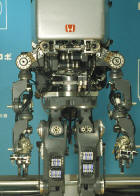 Hardware required to generate Asimo’s motion |
Challenges: The physical
 |
Consider, for example, the challenge of moving a powerful spindle, which is heavy and exerts vibrating side forces, through the precise 3D motion needed to create a small v-carved letter—and then doing another one with completely different shape—all while simultaneously monitoring speed, position, load on motor etc. This is to say that whether it’s putting away a wine glass or cutting plexiglas, producing effective, complex motion is challenging. Motion currently necessitates expensive, complicated, and/or heavy mechanisms. And the hardware for producing motion is the primary immediate challenge for consumer robotics. How do we produce useful movement at affordable prices? |
The Roomba floor-cleaning robot that Gates mentions is actually an exception that illustrates my point. Despite the success of these well-executed little devices (and yes, I think they are neat), they don’t actually clean floors very well. The physical cleaning capabilities that can be provided at a low price is limited. Roomba shows that volume markets can get costs down for the control components. Its sensing, navigation, and robust task software are impressive (you can even get development versions of the little critters). Yet for helper robots to actually be helpful, they need to be able to really do something effective, and that is typically something very physical (like winning the DARPA Challenge, perhaps?).
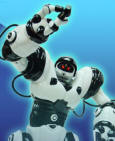 |
As an interesting aside, one mobile robot that has tackled the motion issue with a bit of success is the toy, Robosapiens. These little robots make use of numerous servo motors at articulated joints. At the industrial level producing and controlling this type of motor is quite expensive, but a clever re-engineering of the mechanisms for consumer application has made these little guys available at surprisingly low prices. Unfortunately, they don’t start off doing very much, but numerous hackers have given them more interesting brains that take advantage of some of their motor capabilities (see robosapien1, and my hack below; indeed, there is lots of interesting puttering going on with robotic toys, e.g. Mindstorms, VEX).I suppose that I obsess over the motor, effecter, or output challenges in robotics because that is where we at ShopBot constantly struggle in terms of making robotic tools (CNC) that are affordable. It is not the software or electronics that makes CNC expensive, but rather the cost of the electrical and mechanical effectors that will actually do a reasonable job of cutting, milling, and machining. |
It is certainly the case that solutions to these challenges exist in industrial motion systems, but these are solutions that are oriented to heavy, complex, and capital-intense machines that must be made the focus of a large part of a business operation. They are not solutions that allow putting tools to use by individuals, whether consumers or single workers in production settings.
An example of the CNC mechanical challenge that comes up daily and still has us stymied is the tool changer, a device that will automatically swap out the cutter in a robotic tool. Industrial solutions to this challenge exist in the form of a well developed system of tool holders and draw bars (grabbers for holding the tool holders which hold the cutters).
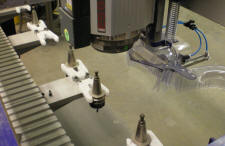 Tool changer system |
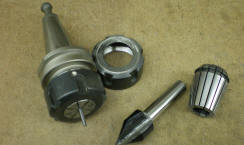 Tool holder and components |
But for a robotic tool that is oriented to individual users this is a very expensive way to change tools. When one of these standard industrial tool-changing systems is fitted to a ShopBot, it costs more than the entire ShopBot. Certainly, our automatic tool-changer works well enough, and it is still much less expensive than the other guys’ CNC with the same changer system, but somehow it does not seem like a solution that is in the right spirit. There is a real challenge here in coming up with a new approach that works, and works for robotic tools that are oriented to use by individuals. [See my prototype here of a new approach.]
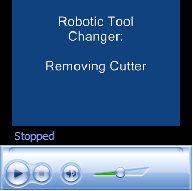 |
<< Here’s my prototype of a new approach to CNC tool changing. |
While we may be able to look to industrial automation technology for ideas on how robotic action can be produced in products designed for use by individuals, at the moment costs are prohibitive and mechanical systems they utilize are not scaled for or oriented to personal use. Other solutions to the motion/mechanical problem may lie in new smart or ‘adaptive’ materials, artificial muscle, or nanotechnology, but these technologies are still a way in the future. More than likely, the near term progress we make in being able to provide affordable motion will be based on multiple small but clever new approaches to accomplishing things in ways which incrementally leverage motion capabilities, physically and conceptually.
Opportunities: First steps in the evolution of human helper robots
Like Gates, I am excited by the prospects of the coming robotic revolution. But to my mind, one of the first and most natural steps in the evolution of human helpers will be the development of robotic tools. Tools that help individuals make and produce things should be able to earn their way into common use. Such personal robotic tools address needs of consumers (particularly of the DIY type) and may soon appeal to those just interested in “replication” in the Star Trek sense of making a needed object on demand (see Jeff Raskins comments on replication from a few years back). Imagine, going to the web for a file representing something you would like made and while online doing some variation or modification to the generic version of the item. Then you would download the file to your robotic tool, shove in a piece of raw material, and have the item come out the other side a few minutes later. [A rudimentary version of such a system is available now; see our ProjectWizard plans.] Such personal robotic tools can empower the productivity of individuals and small groups.
Neil Gershenfeld, of the MIT Media Lab, has a name for this concept of robotic tool use, he calls it ‘Personal Fab’ (from ‘fabrication’; Neil’s book, FAB: The Coming Revolution on Your Desktop – From Personal Computers to Personal Fabrication, Basic Books, 2005). Gershenfeld points out the potential cultural importance of robotic tools when oriented to individual use, a use that universally empowers production. Others have similarly called attention to increased access of individuals to automation and robotics tools as a basis for a new trend in “micro-manufacturing” whereby regional production needs can be increasingly served by networks of very small shops taking advantage of locally available raw materials. Micro-manufacturing has sometimes been suggested a means for third world countries to come on-line technologically; it may just as realistically be a recipe for how American ingenuity revives a new style of American manufacturing. Micro-manufacturing and personal robotic tools also fit well with the growing American entrepreneurial trend towards ‘personal businesses’ (see Intuit Report SR-1037).
Gershenfeld looks to the day when in addition to the ‘subtractive’ capabilities of cutting tools like CNC routers (tools that whack away at a sheet or block of raw material to make something), ‘additive’ robotic tools such as practical 3D printers and will also be at hand. Indeed 3D printers exist. Today’s models are sometimes called rapid prototyping machines, and they are capable of producing 3D objects (check out the Wikipedia entry for rapid prototyping). At this point, the cost is high and because of the materials used, the usefulness of the objects is limited. But these devices certainly lead the imagination to appreciating how new capabilities in additive robotic tools will be increasingly useful – and, maybe it’s not that far off (see www.fabathome.org; or a particularly interesting example for squirting out buildings). [UPDATE 5/8/07; The New York Times just did an enthusiastic report on a new, affordable rapid prototyping product from DeskTop Factory, due out soon for ~$5K. These 3-D printing devices look pretty nifty, but their limitations still make subtractive prototyping tools attractive for their extensive size range and breadth of usable of materials.]
Of course, if you are reading this you already know that consumer robotic tools of the subtractive sort are here … or at least, they are here for a few of us. Maybe as we make ShopBots even more affordable and interactive they will find their way into more basements and garages, but increasingly they are making robotic machining capabilities and production capacity available to individuals and small shops. We look forward to helping them do it more and more …
Now, if there were a C-3PO for the shop, I’d probably be the first to be interested. But despite Asimo (and the Robosapien tool-changer), the likelihood of an affordable, skilled, humanoid robot for productive work in the shop in the near future seems pretty low. Yes, our shops are human-oriented physical environments, but for the first stages of helper bots, we are more likely to benefit from mechanicals designed to handle tools or materials and that help us in simple ways to make or produce things we could not without help.
Robotic tools are the right step in getting robot helpers to individuals because they are based on mechanical systems that are within reach. CNC routers, for example, are basically just large plotters or printers — essentially taking 3-axis motion to the next level. The mechanical challenge of producing effective cutting motion is not nearly as great as say the mechanical challenge of folding laundry.
I believe that consumers are actually ready for these kinds of helpers. It has been very encouraging in the last 10 years to see the emergence of home, computer-controlled, sewing and embroidery machines. These robotic tools leverage existing mechanical systems to get real work done. If one is looking for robots that are earning their keep, these robotic tools may be the best example. Closer to my own interest are the very affordable CNC paper cutters have become available to ‘scrapbookers’ in the last few years. And now, Sears is carrying a small, entry-level CNC carving machine. This nifty little tool really will do stuff in the shop. More importantly, it will help to introduce CNC to consumers and D-I-Yers.
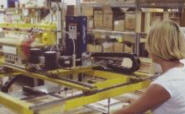 |
Too often CNC tools are associated with industrial automation and repetitive mass production. People are simply unaware of the cutting, machining, and sculpting capabilities that a robotic tool can give them for their one-off projects. Even for industrial or manufacturing applications, it is often not appreciated that while heavy, expensive CNC centers have been the basis for mass production, new ‘lean’ approaches to manufacturing depend on more flexible robotic tools that are oriented to use by individual workers and that rely on rapid reconfiguration with the flow of production (see ShopBots in Manufacturing). |
Gate’s summary point in the article that I mentioned at the start of this column was: that it is now time to get PC’s off the desktop and out into the world and moving around. I have been a believer in this general idea for quite a while — but I would rephrase it a bit more specifically: “It’s time to get PCs off the desktop and doing something productive besides pushing paper”. Robotic tools that accomplish real work are the natural next step in making robotic helpers commonplace.
